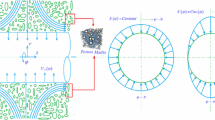Summary
The steady process of evaporation of a liquid flowing in an axial direction through a porous cylinder is considered. The porous cylinder is assumed to be surrounded by a confinement of uniform temperature. The over-all process is analyzed in terms of elementary processes, and the non-dimensional parameters governing the problem are identified. Provided the cylinder is very slender, and sensible heats are negligible in comparison with the latent heat of evaporation, evaporation takes place in a discontinuity of axisymmetric shape. Results of numerical solutions of the basic equations are given, and the effects of various parameters are discussed. It is also shown that an inhomogeneous distribution of permeability in the flow direction can favorably affect the evaporation process.
Similar content being viewed by others
Abbreviations
- A, B :
-
constants in the Antoine equation, cf. Eqs. (18) and (23.3)
- c p :
-
isobaric specific heat capacity
- k p :
-
thermal conductivity of the porous body
- K :
-
dimensionless parameter defined in Eq. (14)
- K * :
-
critical value of the parameterK
- L p, Rp :
-
length and radius of the porous cylinder
- \(\dot m\) :
-
mass flux
- \(\dot m_0 \) :
-
total mass flux, cf. Eq. (19)
- N :
-
viscosity ratio, cf. Eq. (13)
- p :
-
pressure
- P :
-
relative pressure difference,(p 1−p2)/p1
- \(\dot q\) :
-
heat flux
- r :
-
specific latent heat of evaporation
- R :
-
radial coordinate
- St:
-
Stefan number, cf. Eq. (3)
- T :
-
absolute temperature
- T 1 :
-
absolute temperature of the confinement; also temperature upstream of the porous cylinder
- (ΔT)ref :
-
characteristic temperature difference, cf. Eq. (5)
- v :
-
specific volume
- x :
-
vapor mass fraction
- Z :
-
axial coordinate
- α:
-
void fraction of porous material
- ε:
-
slenderness of the porous cylinder, ε=R p/Lp
- Θ:
-
dimensionless temperature difference, cf. Eq. (9)
- Θ 1 :
-
dimensionless temperature difference at confinement, cf. Eq. (12); also dimensionless temperature difference upstream of the porous cylinder
- ϰ:
-
permeability
- \(\bar \kappa \) :
-
mean value of permeability, cf. Eq. (6)
- ϰ*:
-
critical value of permeability, cf. Eq. (15)
- ν:
-
kinematic viscosity
- φ:
-
radius of evaporation front
- a, b :
-
zones of constant permeability, cf. Fig. 1
- 1:
-
upstream of the cylinder
- 2:
-
downstream of the cylinder
- ref:
-
reference quantity
- l :
-
liquid phase
- p :
-
porous cylinder
- s :
-
saturation
- v :
-
vapor phase
- α:
-
beginning of evaporation zone, cf. Fig. 2
- ω:
-
end of evaporation zone, cf. Fig. 2
- ‘:
-
saturated liquid
- “:
-
saturated vapor
- ≈:
-
dimensionless quantity
References
Hohenbichler, G.: Verdampfung von Fluiden beim Durchströmen poröser Körper. Dissertation, TU Wien, 1991.
Schneider, W.: Vapor flow through a porous membrane — a throttling process with condensation and evaporation. Acta Mech.47, 15–25 (1983).
Landolt-Börnstein: Zahlenwerte und Funktionen aus Physik, Chemie, Astronomie, Geophysik und Technik, vol. IVa, part 4. Berlin: Springer 1967.
Author information
Authors and Affiliations
Rights and permissions
About this article
Cite this article
Hohenbichler, G., Köppl, A. & Schneider, W. Evaporation of a liquid flowing through a slender porous cylinder. Acta Mechanica 107, 21–32 (1994). https://doi.org/10.1007/BF01201817
Received:
Issue Date:
DOI: https://doi.org/10.1007/BF01201817



